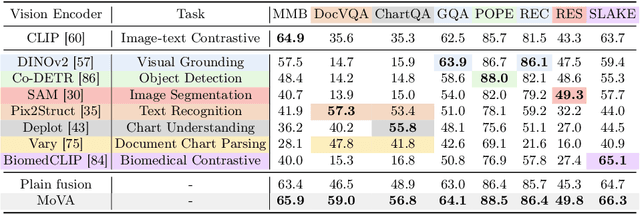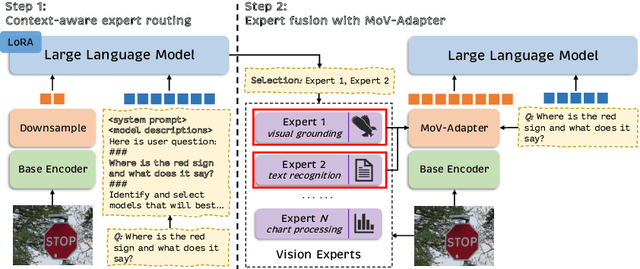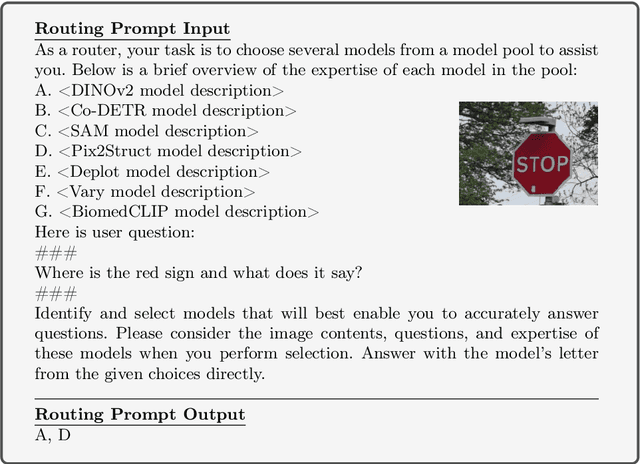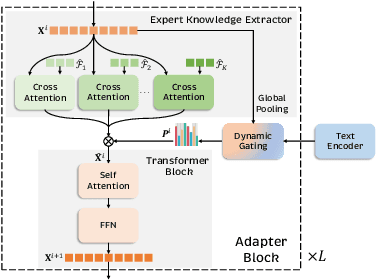Dongzhi Jiang
SciVerse: Unveiling the Knowledge Comprehension and Visual Reasoning of LMMs on Multi-modal Scientific Problems
Mar 13, 2025Abstract:The rapid advancement of Large Multi-modal Models (LMMs) has enabled their application in scientific problem-solving, yet their fine-grained capabilities remain under-explored. In this paper, we introduce SciVerse, a multi-modal scientific evaluation benchmark to thoroughly assess LMMs across 5,735 test instances in five distinct versions. We aim to investigate three key dimensions of LMMs: scientific knowledge comprehension, multi-modal content interpretation, and Chain-of-Thought (CoT) reasoning. To unveil whether LMMs possess sufficient scientific expertise, we first transform each problem into three versions containing different levels of knowledge required for solving, i.e., Knowledge-free, -lite, and -rich. Then, to explore how LMMs interpret multi-modal scientific content, we annotate another two versions, i.e., Vision-rich and -only, marking more question information from texts to diagrams. Comparing the results of different versions, SciVerse systematically examines the professional knowledge stock and visual perception skills of LMMs in scientific domains. In addition, to rigorously assess CoT reasoning, we propose a new scientific CoT evaluation strategy, conducting a step-wise assessment on knowledge and logical errors in model outputs. Our extensive evaluation of different LMMs on SciVerse reveals critical limitations in their scientific proficiency and provides new insights into future developments. Project page: https://sciverse-cuhk.github.io
PiSA: A Self-Augmented Data Engine and Training Strategy for 3D Understanding with Large Models
Mar 13, 2025Abstract:3D Multimodal Large Language Models (MLLMs) have recently made substantial advancements. However, their potential remains untapped, primarily due to the limited quantity and suboptimal quality of 3D datasets. Current approaches attempt to transfer knowledge from 2D MLLMs to expand 3D instruction data, but still face modality and domain gaps. To this end, we introduce PiSA-Engine (Point-Self-Augmented-Engine), a new framework for generating instruction point-language datasets enriched with 3D spatial semantics. We observe that existing 3D MLLMs offer a comprehensive understanding of point clouds for annotation, while 2D MLLMs excel at cross-validation by providing complementary information. By integrating holistic 2D and 3D insights from off-the-shelf MLLMs, PiSA-Engine enables a continuous cycle of high-quality data generation. We select PointLLM as the baseline and adopt this co-evolution training framework to develop an enhanced 3D MLLM, termed PointLLM-PiSA. Additionally, we identify limitations in previous 3D benchmarks, which often feature coarse language captions and insufficient category diversity, resulting in inaccurate evaluations. To address this gap, we further introduce PiSA-Bench, a comprehensive 3D benchmark covering six key aspects with detailed and diverse labels. Experimental results demonstrate PointLLM-PiSA's state-of-the-art performance in zero-shot 3D object captioning and generative classification on our PiSA-Bench, achieving significant improvements of 46.45% (+8.33%) and 63.75% (+16.25%), respectively. We will release the code, datasets, and benchmark.
MME-CoT: Benchmarking Chain-of-Thought in Large Multimodal Models for Reasoning Quality, Robustness, and Efficiency
Feb 13, 2025



Abstract:Answering questions with Chain-of-Thought (CoT) has significantly enhanced the reasoning capabilities of Large Language Models (LLMs), yet its impact on Large Multimodal Models (LMMs) still lacks a systematic assessment and in-depth investigation. In this paper, we introduce MME-CoT, a specialized benchmark evaluating the CoT reasoning performance of LMMs, spanning six domains: math, science, OCR, logic, space-time, and general scenes. As the first comprehensive study in this area, we propose a thorough evaluation suite incorporating three novel metrics that assess the reasoning quality, robustness, and efficiency at a fine-grained level. Leveraging curated high-quality data and a unique evaluation strategy, we conduct an in-depth analysis of state-of-the-art LMMs, uncovering several key insights: 1) Models with reflection mechanism demonstrate a superior CoT quality, with Kimi k1.5 outperforming GPT-4o and demonstrating the highest quality results; 2) CoT prompting often degrades LMM performance on perception-heavy tasks, suggesting a potentially harmful overthinking behavior; and 3) Although the CoT quality is high, LMMs with reflection exhibit significant inefficiency in both normal response and self-correction phases. We hope MME-CoT serves as a foundation for advancing multimodal reasoning in LMMs. Project Page: https://mmecot.github.io/
EasyRef: Omni-Generalized Group Image Reference for Diffusion Models via Multimodal LLM
Dec 12, 2024



Abstract:Significant achievements in personalization of diffusion models have been witnessed. Conventional tuning-free methods mostly encode multiple reference images by averaging their image embeddings as the injection condition, but such an image-independent operation cannot perform interaction among images to capture consistent visual elements within multiple references. Although the tuning-based Low-Rank Adaptation (LoRA) can effectively extract consistent elements within multiple images through the training process, it necessitates specific finetuning for each distinct image group. This paper introduces EasyRef, a novel plug-and-play adaptation method that enables diffusion models to be conditioned on multiple reference images and the text prompt. To effectively exploit consistent visual elements within multiple images, we leverage the multi-image comprehension and instruction-following capabilities of the multimodal large language model (MLLM), prompting it to capture consistent visual elements based on the instruction. Besides, injecting the MLLM's representations into the diffusion process through adapters can easily generalize to unseen domains, mining the consistent visual elements within unseen data. To mitigate computational costs and enhance fine-grained detail preservation, we introduce an efficient reference aggregation strategy and a progressive training scheme. Finally, we introduce MRBench, a new multi-reference image generation benchmark. Experimental results demonstrate EasyRef surpasses both tuning-free methods like IP-Adapter and tuning-based methods like LoRA, achieving superior aesthetic quality and robust zero-shot generalization across diverse domains.
MAVIS: Mathematical Visual Instruction Tuning
Jul 11, 2024



Abstract:Multi-modal Large Language Models (MLLMs) have recently emerged as a significant focus in academia and industry. Despite their proficiency in general multi-modal scenarios, the mathematical problem-solving capabilities in visual contexts remain insufficiently explored. We identify three key areas within MLLMs that need to be improved: visual encoding of math diagrams, diagram-language alignment, and mathematical reasoning skills. This draws forth an urgent demand for large-scale, high-quality data and training pipelines in visual mathematics. In this paper, we propose MAVIS, the first MAthematical VISual instruction tuning paradigm for MLLMs, involving a series of mathematical visual datasets and specialized MLLMs. Targeting the three issues, MAVIS contains three progressive training stages from scratch. First, we curate MAVIS-Caption, consisting of 558K diagram-caption pairs, to fine-tune a math-specific vision encoder (CLIP-Math) through contrastive learning, tailored for improved diagram visual encoding. Second, we utilize MAVIS-Caption to align the CLIP-Math with a large language model (LLM) by a projection layer, enhancing vision-language alignment in mathematical domains. Third, we introduce MAVIS-Instruct, including 900K meticulously collected and annotated visual math problems, which is adopted to finally instruct-tune the MLLM for robust mathematical reasoning skills. In MAVIS-Instruct, we incorporate complete chain-of-thought (CoT) rationales for each problem, and minimize textual redundancy, thereby concentrating the model towards the visual elements. Data and Models are released at https://github.com/ZrrSkywalker/MAVIS
MoVA: Adapting Mixture of Vision Experts to Multimodal Context
Apr 19, 2024



Abstract:As the key component in multimodal large language models (MLLMs), the ability of the visual encoder greatly affects MLLM's understanding on diverse image content. Although some large-scale pretrained vision encoders such as vision encoders in CLIP and DINOv2 have brought promising performance, we found that there is still no single vision encoder that can dominate various image content understanding, e.g., the CLIP vision encoder leads to outstanding results on general image understanding but poor performance on document or chart content. To alleviate the bias of CLIP vision encoder, we first delve into the inherent behavior of different pre-trained vision encoders and then propose the MoVA, a powerful and novel MLLM, adaptively routing and fusing task-specific vision experts with a coarse-to-fine mechanism. In the coarse-grained stage, we design a context-aware expert routing strategy to dynamically select the most suitable vision experts according to the user instruction, input image, and expertise of vision experts. This benefits from the powerful model function understanding ability of the large language model (LLM) equipped with expert-routing low-rank adaptation (LoRA). In the fine-grained stage, we elaborately conduct the mixture-of-vision-expert adapter (MoV-Adapter) to extract and fuse task-specific knowledge from various experts. This coarse-to-fine paradigm effectively leverages representations from experts based on multimodal context and model expertise, further enhancing the generalization ability. We conduct extensive experiments to evaluate the effectiveness of the proposed approach. Without any bells and whistles, MoVA can achieve significant performance gains over current state-of-the-art methods in a wide range of challenging multimodal benchmarks. Codes and models will be available at https://github.com/TempleX98/MoVA.
CoMat: Aligning Text-to-Image Diffusion Model with Image-to-Text Concept Matching
Apr 04, 2024



Abstract:Diffusion models have demonstrated great success in the field of text-to-image generation. However, alleviating the misalignment between the text prompts and images is still challenging. The root reason behind the misalignment has not been extensively investigated. We observe that the misalignment is caused by inadequate token attention activation. We further attribute this phenomenon to the diffusion model's insufficient condition utilization, which is caused by its training paradigm. To address the issue, we propose CoMat, an end-to-end diffusion model fine-tuning strategy with an image-to-text concept matching mechanism. We leverage an image captioning model to measure image-to-text alignment and guide the diffusion model to revisit ignored tokens. A novel attribute concentration module is also proposed to address the attribute binding problem. Without any image or human preference data, we use only 20K text prompts to fine-tune SDXL to obtain CoMat-SDXL. Extensive experiments show that CoMat-SDXL significantly outperforms the baseline model SDXL in two text-to-image alignment benchmarks and achieves start-of-the-art performance.
MathVerse: Does Your Multi-modal LLM Truly See the Diagrams in Visual Math Problems?
Mar 21, 2024



Abstract:The remarkable progress of Multi-modal Large Language Models (MLLMs) has garnered unparalleled attention, due to their superior performance in visual contexts. However, their capabilities in visual math problem-solving remain insufficiently evaluated and understood. We investigate current benchmarks to incorporate excessive visual content within textual questions, which potentially assist MLLMs in deducing answers without truly interpreting the input diagrams. To this end, we introduce MathVerse, an all-around visual math benchmark designed for an equitable and in-depth evaluation of MLLMs. We meticulously collect 2,612 high-quality, multi-subject math problems with diagrams from publicly available sources. Each problem is then transformed by human annotators into six distinct versions, each offering varying degrees of information content in multi-modality, contributing to 15K test samples in total. This approach allows MathVerse to comprehensively assess whether and how much MLLMs can truly understand the visual diagrams for mathematical reasoning. In addition, we propose a Chain-of-Thought (CoT) evaluation strategy for a fine-grained assessment of the output answers. Rather than naively judging True or False, we employ GPT-4(V) to adaptively extract crucial reasoning steps, and then score each step with detailed error analysis, which can reveal the intermediate CoT reasoning quality by MLLMs. We hope the MathVerse benchmark may provide unique insights to guide the future development of MLLMs. Project page: https://mathverse-cuhk.github.io
Temporal Enhanced Training of Multi-view 3D Object Detector via Historical Object Prediction
Apr 03, 2023Abstract:In this paper, we propose a new paradigm, named Historical Object Prediction (HoP) for multi-view 3D detection to leverage temporal information more effectively. The HoP approach is straightforward: given the current timestamp t, we generate a pseudo Bird's-Eye View (BEV) feature of timestamp t-k from its adjacent frames and utilize this feature to predict the object set at timestamp t-k. Our approach is motivated by the observation that enforcing the detector to capture both the spatial location and temporal motion of objects occurring at historical timestamps can lead to more accurate BEV feature learning. First, we elaborately design short-term and long-term temporal decoders, which can generate the pseudo BEV feature for timestamp t-k without the involvement of its corresponding camera images. Second, an additional object decoder is flexibly attached to predict the object targets using the generated pseudo BEV feature. Note that we only perform HoP during training, thus the proposed method does not introduce extra overheads during inference. As a plug-and-play approach, HoP can be easily incorporated into state-of-the-art BEV detection frameworks, including BEVFormer and BEVDet series. Furthermore, the auxiliary HoP approach is complementary to prevalent temporal modeling methods, leading to significant performance gains. Extensive experiments are conducted to evaluate the effectiveness of the proposed HoP on the nuScenes dataset. We choose the representative methods, including BEVFormer and BEVDet4D-Depth to evaluate our method. Surprisingly, HoP achieves 68.5% NDS and 62.4% mAP with ViT-L on nuScenes test, outperforming all the 3D object detectors on the leaderboard. Codes will be available at https://github.com/Sense-X/HoP.
 Add to Chrome
Add to Chrome Add to Firefox
Add to Firefox Add to Edge
Add to Edge